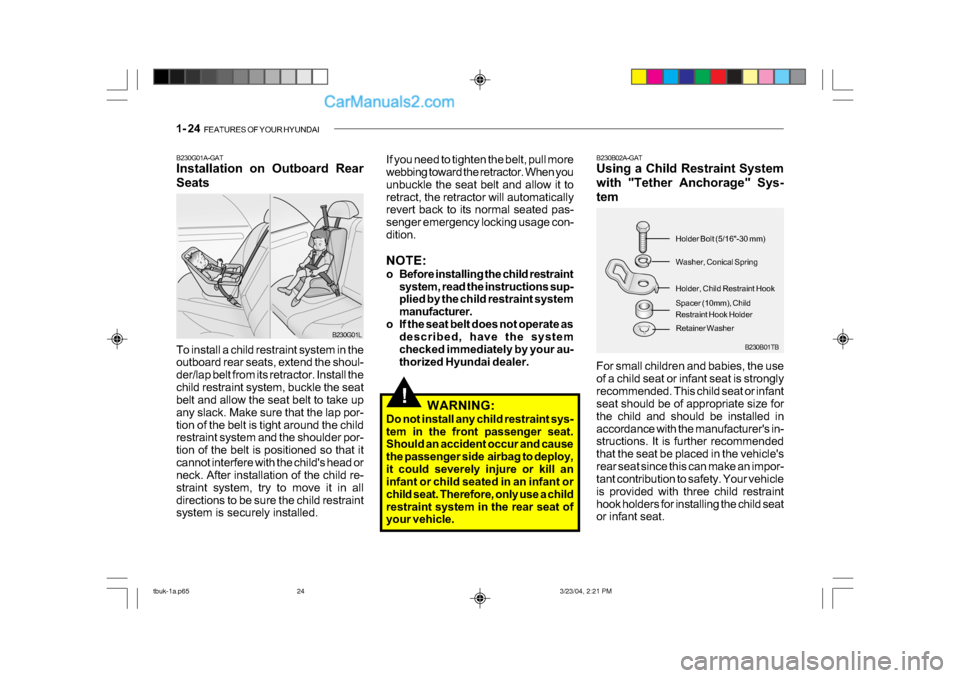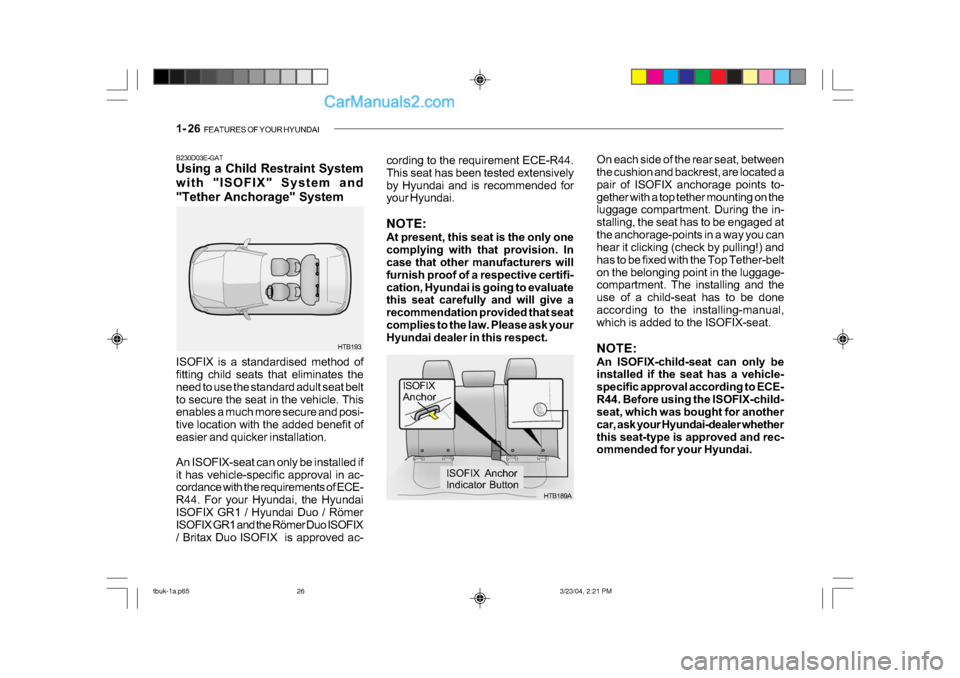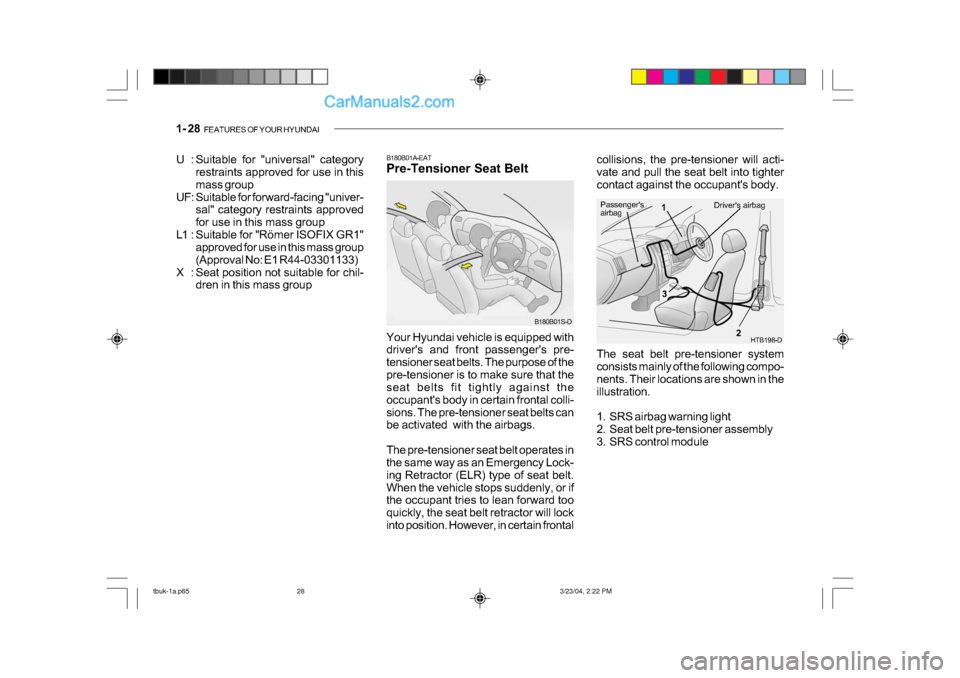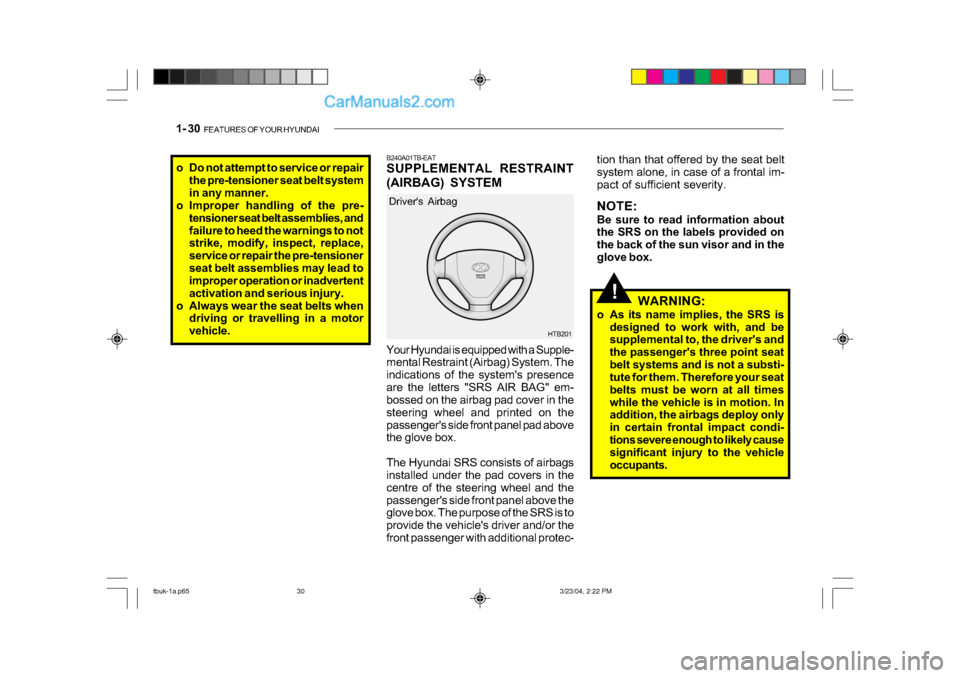2004 Hyundai Getz seat belt
[x] Cancel search: seat beltPage 282 of 445

1- 24 FEATURES OF YOUR HYUNDAI
!WARNING:
Do not install any child restraint sys-
tem in the front passenger seat.
Should an accident occur and cause
the passenger side airbag to deploy,
it could severely injure or kill an
infant or child seated in an infant or
child seat. Therefore, only use a child
restraint system in the rear seat of
your vehicle.
If you need to tighten the belt, pull more
webbing toward the retractor. When you
unbuckle the seat belt and allow it to
retract, the retractor will automatically
revert back to its normal seated pas-
senger emergency locking usage con-
dition.
NOTE:
o Before installing the child restraint
system, read the instructions sup-
plied by the child restraint system
manufacturer.
o If the seat belt does not operate as described, have the system
checked immediately by your au-
thorized Hyundai dealer.
B230B01TB
B230B02A-GAT
Using a Child Restraint System
with "Tether Anchorage" Sys-
tem
For small children and babies, the use
of a child seat or infant seat is strongly
recommended. This child seat or infant
seat should be of appropriate size for
the child and should be installed in
accordance with the manufacturer's in-
structions. It is further recommended
that the seat be placed in the vehicle's
rear seat since this can make an impor-
tant contribution to safety. Your vehicle
is provided with three child restraint
hook holders for installing the child seat
or infant seat. Spacer (10mm), Child
Restraint Hook Holder
Holder Bolt (5/16"-30 mm)
Washer, Conical Spring
Holder, Child Restraint Hook
Retainer Washer
To install a child restraint system in the
outboard rear seats, extend the shoul-
der/lap belt from its retractor. Install the
child restraint system, buckle the seat
belt and allow the seat belt to take up
any slack. Make sure that the lap por-
tion of the belt is tight around the child
restraint system and the shoulder por-
tion of the belt is positioned so that it
cannot interfere with the child's head or
neck. After installation of the child re-
straint system, try to move it in all
directions to be sure the child restraint
system is securely installed.B230G01A-GAT
Installation on Outboard Rear
Seats
B230G01L
tbuk-1a.p65
3/23/04, 2:21 PM
24
Page 284 of 445

1- 26 FEATURES OF YOUR HYUNDAI
On each side of the rear seat, between
the cushion and backrest, are located a
pair of ISOFIX anchorage points to-
gether with a top tether mounting on the
luggage compartment. During the in-
stalling, the seat has to be engaged at
the anchorage-points in a way you can
hear it clicking (check by pulling!) and
has to be fixed with the Top Tether-belt
on the belonging point in the luggage-
compartment. The installing and the
use of a child-seat has to be done
according to the installing-manual,
which is added to the ISOFIX-seat.
NOTE:
An ISOFIX-child-seat can only be
installed if the seat has a vehicle-
specific approval according to ECE-
R44. Before using the ISOFIX-child-
seat, which was bought for another
car, ask your Hyundai-dealer whether
this seat-type is approved and rec-
ommended for your Hyundai.
cording to the requirement ECE-R44.
This seat has been tested extensively
by Hyundai and is recommended for
your Hyundai.
NOTE:
At present, this seat is the only one
complying with that provision. In
case that other manufacturers will
furnish proof of a respective certifi-
cation, Hyundai is going to evaluate
this seat carefully and will give a
recommendation provided that seat
complies to the law. Please ask your
Hyundai dealer in this respect.
HTB189A
ISOFIX
Anchor
ISOFIX Anchor
Indicator Button
B230D03E-GAT
Using a Child Restraint System
with "ISOFIX" System and
"Tether Anchorage" System
ISOFIX is a standardised method of
fitting child seats that eliminates the
need to use the standard adult seat belt
to secure the seat in the vehicle. This
enables a much more secure and posi-
tive location with the added benefit of
easier and quicker installation.
An ISOFIX-seat can only be installed if
it has vehicle-specific approval in ac-
cordance with the requirements of ECE-
R44. For your Hyundai, the Hyundai
ISOFIX GR1 / Hyundai Duo / R
Page 286 of 445

1- 28 FEATURES OF YOUR HYUNDAI
B180B01A-EAT
Pre-Tensioner Seat Belt
B180B01S-D
Your Hyundai vehicle is equipped with
driver's and front passenger's pre-
tensioner seat belts. The purpose of the
pre-tensioner is to make sure that the
seat belts fit tightly against the
occupant's body in certain frontal colli-
sions. The pre-tensioner seat belts can
be activated with the airbags.
The pre-tensioner seat belt operates in
the same way as an Emergency Lock-
ing Retractor (ELR) type of seat belt.
When the vehicle stops suddenly, or if
the occupant tries to lean forward too
quickly, the seat belt retractor will lock
into position. However, in certain frontal
collisions, the pre-tensioner will acti-
vate and pull the seat belt into tighter
contact against the occupant's body.
The seat belt pre-tensioner system
consists mainly of the following compo-
nents. Their locations are shown in the
illustration.
1. SRS airbag warning light
2. Seat belt pre-tensioner assembly
3. SRS control module HTB198-D
Driver's airbag1
2
3Passenger's
airbag
U : Suitable for "universal" category
restraints approved for use in this
mass group
UF: Suitable for forward-facing "univer- sal" category restraints approved
for use in this mass group
L1 : Suitable for "R
Page 287 of 445

FEATURES OF YOUR HYUNDAI 1- 29
!
o Although it is harmless, the fine
dust may cause skin irritation and
should not be breathed for pro-
longed periods. Wash your hands
and face thoroughly after an acci-
dent in which the pre-tensioner
seat belts were activated. it illuminates whilst the vehicle is
being driven, please have an au-
thorized Hyundai dealer inspect
the pre-tensioner seat belt or SRS
airbag system as soon as pos-
sible.
CAUTION:
o Because the sensor that activates the SRS airbag is connected with
the pre-tensioner seat belt, the SRS
airbag warning light on the
instrument panel will blink for
approximately 6 seconds after the
ignition key has been turned to the
"ON" position and then it should
turn off.
o If the pre-tensioner seat belt is not working properly, this warning
light will illuminate even if there is
no function of the SRS airbag sys-
tem.
If the SRS airbag warning light
does not illuminate when the igni-
tion key is turned to "ON", or if it
remains illuminated after blinking
for approximately 6 seconds, or if WARNING:
o Pre-tensioners are designed to op- erate only one time. After activa-
tion, pre-tensioner seat belts must
be replaced. All seat belts, of any
type, should always be replaced
after they have been worn during a
collision.
o The pre-tensioner seat belt assem-
bly mechanisms become hot dur-
ing activation. Do not touch the
pre-tensioner seat belt assemblies
for several minutes after they have
been activated.
o Do not attempt to inspect or re-
place the pre-tensioner seat belts
yourself. This must be done by an
authorized Hyundai dealer.
o Do not strike the pre-tensioner seat
belt assemblies.
!
!WARNING:
To obtain maximum benefit from a
pre-tensioner seat belt:
1. The seat belt must be worn cor- rectly.
2. The seat belt must be adjusted to the correct position.
NOTE:
o Both the driver's and front passenger's pre-tensioner seat
belts will be activated in certain
frontal collisions. The pre-
tensioner seat belts can be acti-
vated with the airbags. The pre-
tensioners will be activated under
these conditions even if the seat
belts are not being worn at the
time of the collision.
o When the pre-tensioner seat belts
are activated, a loud noise may be
heard and fine dust, which may
appear to be smoke, may be vis-
ible in the passenger compart-
ment. These are normal operating
conditions and are not hazard-
ous.
tbuk-1a.p65 3/23/04, 2:22 PM
29
Page 288 of 445

1- 30 FEATURES OF YOUR HYUNDAI
!
HTB201
Driver's Airbag
Your Hyundai is equipped with a Supple-
mental Restraint (Airbag) System. The
indications of the system's presence
are the letters "SRS AIR BAG" em-
bossed on the airbag pad cover in the
steering wheel and printed on the
passenger's side front panel pad above
the glove box.
The Hyundai SRS consists of airbags
installed under the pad covers in the
centre of the steering wheel and the
passenger's side front panel above the
glove box. The purpose of the SRS is to
provide the vehicle's driver and/or the
front passenger with additional protec- B240A01TB-EAT
SUPPLEMENTAL RESTRAINT
(AIRBAG) SYSTEM
tion than that offered by the seat belt
system alone, in case of a frontal im-
pact of sufficient severity.
NOTE:
Be sure to read information about
the SRS on the labels provided on
the back of the sun visor and in the
glove box.
WARNING:
o As its name implies, the SRS is designed to work with, and be
supplemental to, the driver's and
the passenger's three point seat
belt systems and is not a substi-
tute for them. Therefore your seat
belts must be worn at all times
while the vehicle is in motion. In
addition, the airbags deploy only
in certain frontal impact condi-
tions severe enough to likely cause
significant injury to the vehicle
occupants.
o Do not attempt to service or repairthe pre-tensioner seat belt system
in any manner.
o Improper handling of the pre-
tensioner seat belt assemblies, and
failure to heed the warnings to not
strike, modify, inspect, replace,
service or repair the pre-tensioner
seat belt assemblies may lead to
improper operation or inadvertent
activation and serious injury.
o Always wear the seat belts when driving or travelling in a motor
vehicle.
tbuk-1a.p65 3/23/04, 2:22 PM
30
Page 289 of 445

FEATURES OF YOUR HYUNDAI 1- 31
o For maximum safety protection in
all types of crashes, all occupants
including the driver should always
wear their seat belts whether or
not an airbag is also provided at
their seating position to minimize
the risk of severe injury or death in
the event of a crash. Do not sit or
lean unnecessarily close to the
airbag while the vehicle is in mo-
tion.
o The SRS airbag system must de-
ploy very rapidly to provide pro-
tection in a crash. If an occupant is
out of position because of not
wearing a seat belt, the airbag may
forcefully contact the occupant
causing serious or fatal injuries.
The SRS consists of the following com-
ponents:
- Driver's Airbag Module
- Passenger's Airbag Module
- SRS Service Reminder Indicator (SRI)
- SRS Control Module (SRSCM)
The SRSCM continually monitors all
elements while the ignition is "ON" to
determine if a frontal or near-frontal
impact is severe enough to require
airbag deployment. B240B03A-DAT
SRS Components and Functions
B240B01L-D
HTB203
Rear impact
Side Impact Rollover
o The SRS is designed to deploy the
airbags only when an impact is
sufficiently severe and when the
impact angle is less than 30
Page 290 of 445

1- 32 FEATURES OF YOUR HYUNDAI
B240B03L-D
The airbag modules are located both in
the centre of the steering wheel and in
the front passenger's panel above the
glove box. When the SRSCM detects a
considerable impact to the front of the
vehicle, it will automatically deploy the
airbags.
Passenger's Airbag
HTB204-D
Upon deployment, tear seams molded
directly into the pad covers will sepa-
rate under pressure from the expansion
of the airbags. Further opening of the
covers then allows full inflation of the
airbags.
A fully inflated airbag in combination
with a properly worn seat belt slows the
driver's or the passenger's forward mo-
tion, thus reducing the risk of head or
chest injury.
The SRS service reminder indicator
(SRI) on the instrument panel will blink
for about 6 seconds after the ignition
key is turned to the "ON" position or
after the engine is started, after which
the SRI should go out.
B240B02L-D
tbuk-1a.p65
3/23/04, 2:22 PM
32
Page 292 of 445

1- 34 FEATURES OF YOUR HYUNDAI
!
Side airbag
sensor
WARNING:
o The side impact airbag is supple- mental to the driver's and the
passenger's three point seat belt
systems and is not a substitute for
them. Therefore your seat belts
must be worn at all times whilst
the vehicle is in motion. The
airbags deploy only in certain side
impact conditions severe enough
to cause significant injury to the
vehicle occupants. HTB072-D
o For best protection from the side
airbag system and to avoid being
injured is by the deploying side
impact airbag, both front seat oc-
cupants should sit in an upright
position with the seat belt prop-
erly fastened. The driver's hands
should be placed on the steering
wheel at the 9:00 and 3:00 o'clock
positions. The passenger's arms
and hands should be placed in
their laps.
o Do not use any accessory seat covers.
o Use of seat covers could reduce or
prevent the effectiveness of the
system.
o Do not install any accessories on
the side or near the side impact
airbag.
o Do not use excessive force on the
side of the seat.
o Do not place any objects over the airbag or between the airbag and
yourself.
B990B04Y-EAT
Side Impact Airbag
Your Hyundai is equipped with a side
impact airbag in each front seat. The
purpose of the airbag is to provide the
vehicle's driver and/or the front passen-
ger with additional protection than that
offered by the seat belt alone. The side
impact airbags are designed to deploy
only during certain side impact colli-
sions, depending on the crash severity,
angle, speed and point of impact. The
air bags are not designed to deploy in all
side impact situations.
B990B02Y-D
tbuk-1a.p65
3/23/04, 2:22 PM
34